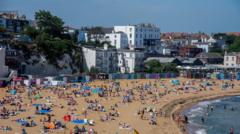Could a 100-Foot Mega Tsunami Strike the US Soon?

Understanding the Cascadia Subduction Zone and Its Tsunami Threat
The prospect of a mega tsunami striking the U.S. West Coast is a topic that evokes both fear and urgency. Scientists are sounding the alarm about the potential for a devastating natural disaster originating from the Cascadia Subduction Zone, a major geological fault line that stretches nearly 700 miles along the Pacific Northwest, from northern California to British Columbia. This article delves into the science behind this impending threat, what it means for coastal communities, and the critical steps that can be taken to mitigate the risks associated with such a catastrophic event.
The Cascadia Subduction Zone: An Overview
The Cascadia Subduction Zone (CSZ) is an area where two tectonic plates—the Juan de Fuca Plate and the North American Plate—meet. The Juan de Fuca Plate is slowly being pushed beneath the North American Plate in a process known as subduction. This movement is responsible for significant seismic activity, including earthquakes and tsunamis.
Seismic History and Current Threat Level
Historically, the last major earthquake in the CSZ occurred on January 26, 1700, when a magnitude 9.0 quake struck, leading to a tsunami that devastated coastal areas, including the village of Pachena Bay in British Columbia. Since then, the region has experienced a relative quiet period, but this tranquility is deceptive. Current research indicates that the CSZ is overdue for a significant seismic event, and the likelihood of one occurring in the next 50 years is alarmingly high.
- There is a 37% chance of a magnitude 8.0 to 9.0 earthquake occurring in the Pacific Northwest by 2073.
- The chance of a major earthquake is nearly guaranteed by the year 2100.
- Experts warn that the effects of climate change, such as rising sea levels, will compound the hazards associated with such an earthquake.
The Tsunami Risk: What to Expect
A major earthquake along the CSZ could generate a tsunami reaching heights of up to 100 feet. Such a tsunami would have catastrophic implications for coastal communities in California, Oregon, Washington, and extending to northern Vancouver Island in Canada. The Federal Emergency Management Agency (FEMA) estimates that thousands of lives could be lost as a result of this disaster, with projections indicating:
- 5,800 deaths due to the earthquake itself.
- Another 8,000 lives at risk from the ensuing tsunami.
The Impacts on Coastal Communities
The consequences of a mega tsunami would extend far beyond immediate fatalities. After the wave recedes, the landscape will be irrevocably altered. The land is expected to settle at lower elevations, resulting in:
- Significantly expanded floodplains, affecting infrastructure like roads and buildings.
- Long-term changes to ecosystems and habitats along the coast.
- Increased vulnerability to future flooding events due to climate change, as projected sea levels continue to rise.
Preparedness and Mitigation Strategies
Given the significant risk posed by the Cascadia Subduction Zone, it is crucial for coastal communities to take proactive measures to prepare for a potentially catastrophic event. Here are several strategies that can enhance resilience:
1. Community Education and Awareness
Education is key to preparedness. Communities should be informed about the risks associated with the CSZ and the necessary actions to take in the event of an earthquake or tsunami. Public seminars, workshops, and drills can help residents understand:
- How to recognize earthquake warnings.
- The importance of having an emergency kit ready.
- The safest evacuation routes and assembly points.
2. Infrastructure Resilience
Building codes in coastal areas should be updated to ensure that new constructions can withstand the impacts of both earthquakes and tsunamis. This includes:
- Reinforced buildings designed to absorb seismic shocks.
- Strategically placed barriers to mitigate tsunami impacts.
- Investments in flood-resistant infrastructure.
3. Early Warning Systems
Developing and maintaining early warning systems can provide critical information to residents in real-time. These systems should include:
- Seismic monitoring to detect earthquakes as they happen.
- Automated alerts sent to mobile devices, radios, and community alert systems.
- Regular testing and updating of the alert systems for reliability.
4. Emergency Response Planning
Communities must develop comprehensive emergency response plans that encompass:
- Coordination with local, state, and federal agencies for disaster response.
- Evacuation protocols and resources for those with mobility challenges.
- Plans for sheltering displaced individuals after a disaster.
The Role of Climate Change in Tsunami Risk
Climate change is intricately linked to the risks posed by the Cascadia Subduction Zone. As global temperatures rise, sea levels are expected to increase, exacerbating the impacts of any potential tsunami. According to recent studies, by 2100, rising sea levels could:
- Triple the flooding exposure for coastal residents compared to current levels.
- Impact infrastructure and ecosystems, making recovery more challenging.
Long-Term Planning for Resilience
To address these escalating risks, it is vital for local governments and communities to integrate climate considerations into long-term planning efforts. This may include:
- Zoning regulations that restrict development in high-risk areas.
- Investment in natural barriers, such as wetlands and dunes, that can help absorb wave energy.
- Collaboration with scientists and policymakers to develop adaptive strategies for future challenges.
Conclusion
The threat of a mega tsunami from the Cascadia Subduction Zone is real and imminent. As scientists warn of the potential for catastrophic events within the next several decades, it is essential for communities along the West Coast to prepare and adapt. By investing in education, infrastructure resilience, early warning systems, and comprehensive emergency response planning, we can mitigate the risks that accompany this natural disaster. The time to act is now—our collective safety depends on it.
Frequently Asked Questions
What is the Cascadia Subduction Zone?
The Cascadia Subduction Zone is a nearly 700-mile-long fault line along the U.S. West Coast where the Juan de Fuca Plate is being pushed beneath the North American Plate, leading to significant seismic activity, including earthquakes and tsunamis.
How likely is a mega tsunami to occur in the next 50 years?
There is a 37% chance of a magnitude 8.0 to 9.0 earthquake occurring in the Pacific Northwest within the next 50 years, which could generate a mega tsunami.
What are the potential impacts of a tsunami from the Cascadia Subduction Zone?
A tsunami generated by a significant earthquake could result in thousands of deaths, flood extensive areas along the coast, and alter the landscape for decades or even centuries.
What can communities do to prepare for a tsunami?
Communities can enhance preparedness through education, updating building codes for resilience, establishing early warning systems, and developing comprehensive emergency response plans.
As we contemplate the reality of a mega tsunami, how can you contribute to your community’s preparedness? #CascadiaSubductionZone #TsunamiPreparedness #DisasterResilience
Published: 2025-07-10 19:34:34 | Category: News



